The push was on. America’s war was entering its third year, and there was a certain sense of urgency as to when and how the whole affair would end. The enemy wasn’t taking much in the way of new ground, but still stubbornly held to what it already had. The Italians had weakened, but Germany and Japan remained America’s favorite foes. Walt Disney’s and other’s futuristic visions of bringing about a cessation of hostilities by a major campaign of attack upon the enemy’s interior would ultimately lead to the massed offensive of D-Day, while bombing raids attempted to penetrate deeper and deeper over enemy lines. The themes of animation seem to mirror this trend, with increasing emphasis on taking the battle to the enemy rather than merely holding territorial lines of defense. Some visionaries actually began to see the chance of light at the end of the tunnel, and allowed their imaginations to delve into visions of what a post-war future might be, once the foe was vanquished. While fraught with continuing danger, the outlook thus held out a ray of hope, which must have seemed a shot in the arm for the morale of a war-weary world.

The Pelican and the Snipe (Disney/RKO, 1/7/44 – Hamilton Luske, dir.) – The last of Disney’s “searchlight series” of one-shots during the war years. Its South American setting betrays that it was intended as a segment for “The Three Caballeros” (possibly for inclusion in the “Avas Raras” sequence). However, its war angle would have been jarring in its inclusion into such feature, as it would have been the only element so dating itself to prevent meaningful use of the film in reissue. Plus, it would seem to be overdoing things to have Sterling Holloway narrating two complete stand-alone stories within the same feature, as he already had the segment, “The Cold-Blooded Penguin” lined up for the beginning of the program. So, the decision was wisely made to market this extraneous piece of fluff upon its own merits – ultimately leaving it largely forgotten in the dust of time.
 Mr. Holloway is not at his best in this presentation. Others besides myself have observed that the film is considerably over-narrated, in many places where the visuals alone could have adequately told the tale. (This fault, in my opinion, was, to a lesser degree, committed again in the later production, “Peter and the Wolf”. Only Jerry Colonna could really get away with it, as any extra dialogue from him was genuinely funny in its own right.) The story is also not among Disney’s strongest – an odd tale of the friendship between two sea birds, strained by the pelican’s habit of flying in his sleep. His pal the snipe keeps a vigil each night to keep the sleeping pelican out of trouble – usually having to play co-pilot to steer the sleeping sea-bird by the beak, to keep him from “dive-bombing” into the rocky coast, being swallowed by sharks, or crashing into the side of the lighthouse they call their home. Oddly, the snipe never speaks, so the pelican knows nothing of his friend’s efforts. (How do they maintain a friendship anyway without effective communication?) The pelican is fresh as a daisy by day, and intolerant of why his pal is always dead tired. It is further established that the pelican is crazy about planes, observing and copying the flight styles of numerous fighters and bombers from a nearby air base in Montevideo.
Mr. Holloway is not at his best in this presentation. Others besides myself have observed that the film is considerably over-narrated, in many places where the visuals alone could have adequately told the tale. (This fault, in my opinion, was, to a lesser degree, committed again in the later production, “Peter and the Wolf”. Only Jerry Colonna could really get away with it, as any extra dialogue from him was genuinely funny in its own right.) The story is also not among Disney’s strongest – an odd tale of the friendship between two sea birds, strained by the pelican’s habit of flying in his sleep. His pal the snipe keeps a vigil each night to keep the sleeping pelican out of trouble – usually having to play co-pilot to steer the sleeping sea-bird by the beak, to keep him from “dive-bombing” into the rocky coast, being swallowed by sharks, or crashing into the side of the lighthouse they call their home. Oddly, the snipe never speaks, so the pelican knows nothing of his friend’s efforts. (How do they maintain a friendship anyway without effective communication?) The pelican is fresh as a daisy by day, and intolerant of why his pal is always dead tired. It is further established that the pelican is crazy about planes, observing and copying the flight styles of numerous fighters and bombers from a nearby air base in Montevideo.
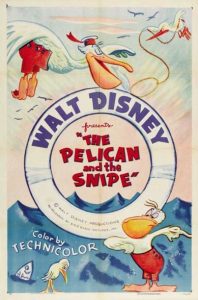 By night, the snipe wracks his brain to think of a way to stop the pelican’s dangerous flights. Tying a rope from the pelican’s foot to his own only gets the snipe dragged along for the ride again, and almost keeps him from steering the pelican out of danger when the rope winds around and binds the snipe to the pelican’s feet. The snipe envisions other possible solitions, including locking the pelican in irons, stocks, or a bird cage, but instead tries chaining the pelican to a large sea anchor. Even this fails to hold, upon the smooth surface of the lighthouse roof, and the pelican merely tugs the heavy object over the side, getting dragged down into the sea for a wet awakening. The pelican interprets this as a mean-spirited practical joke, and banishes the snipe from the lighthouse without learning the real truth. (Again, why doesn’t the snipe speak up for himself.) That night, with no one to watch over him, the pelican “solos”, taking to the air in the belief he is a flying fortress. However, he is not alone, as the bombers nearby are out on night maneuvers. A collision between the prop of one of the planes and the pelican’s tail brings about a rude awakening – and the pelican’s realization as to how he wound up in the air. Suddenly, the truth dawns on him in an instant, and he somehow realizes (without even the advice of the narrator) that his friend must have been trying to help him – a lot to realize in a mere 5 seconds of film footage. To make things more implausible, the pelican looks down, to discover the otherwise wise snipe, asleep below, foolishly lying upon a platform clearly marked with a bulls-eye to the air for the approaching bombers’ target practice. A series of bombs fall from planes above past the pelican, blasting the four corners off the target, with the exhausted snipe still asleep and undisturbed in the middle. As a final bomb falls, dead-on in aim, the pelican returns the favor to the snipe, out-diving the bomb to perform a split-second rescue of the snipe just before the bomb’s impact. The final scene takes place the next night. The snipe is finally getting some sleep, despite his friend’s persistent flying problem – as he has tethered the pelican to a previously-unseen weather vane atop the lighthouse, allowing the pelican to fly all he wants through the night, but in a safe circular path around the roof. Mr. Holloway points out the only possible flaw – that the snipe will be dealing with a pretty dizzy pelican by morning.
By night, the snipe wracks his brain to think of a way to stop the pelican’s dangerous flights. Tying a rope from the pelican’s foot to his own only gets the snipe dragged along for the ride again, and almost keeps him from steering the pelican out of danger when the rope winds around and binds the snipe to the pelican’s feet. The snipe envisions other possible solitions, including locking the pelican in irons, stocks, or a bird cage, but instead tries chaining the pelican to a large sea anchor. Even this fails to hold, upon the smooth surface of the lighthouse roof, and the pelican merely tugs the heavy object over the side, getting dragged down into the sea for a wet awakening. The pelican interprets this as a mean-spirited practical joke, and banishes the snipe from the lighthouse without learning the real truth. (Again, why doesn’t the snipe speak up for himself.) That night, with no one to watch over him, the pelican “solos”, taking to the air in the belief he is a flying fortress. However, he is not alone, as the bombers nearby are out on night maneuvers. A collision between the prop of one of the planes and the pelican’s tail brings about a rude awakening – and the pelican’s realization as to how he wound up in the air. Suddenly, the truth dawns on him in an instant, and he somehow realizes (without even the advice of the narrator) that his friend must have been trying to help him – a lot to realize in a mere 5 seconds of film footage. To make things more implausible, the pelican looks down, to discover the otherwise wise snipe, asleep below, foolishly lying upon a platform clearly marked with a bulls-eye to the air for the approaching bombers’ target practice. A series of bombs fall from planes above past the pelican, blasting the four corners off the target, with the exhausted snipe still asleep and undisturbed in the middle. As a final bomb falls, dead-on in aim, the pelican returns the favor to the snipe, out-diving the bomb to perform a split-second rescue of the snipe just before the bomb’s impact. The final scene takes place the next night. The snipe is finally getting some sleep, despite his friend’s persistent flying problem – as he has tethered the pelican to a previously-unseen weather vane atop the lighthouse, allowing the pelican to fly all he wants through the night, but in a safe circular path around the roof. Mr. Holloway points out the only possible flaw – that the snipe will be dealing with a pretty dizzy pelican by morning.
 The Helicopter (Terrytoons/Fox, 1/21/44 Eddie Donnelly, dir.) – It’s back to the toy department of a department store for this one – a film slim on plot, and definitely aimed at the smaller kiddies. An establishing shot provides a total animation cheat, depicting mice lying in wait in the building’s basement for a call of “all clear” from a mouse in an air raid warden hat. The shot is depicted as a totally still background, with about thirty mice not moving a muscle, or even batting an eyelid! Also, the layout artists can’t seem to figure out the location of the story, as an exterior background depicts an old-fashioned small shop locked up by a single elderly proprietor, while interior shots depict a freight elevator with five sub-basements, and a central multi-story sales rotunda that would rival New York’s Macy’s! The mice gather in the freight elevator and proceed upwards to the toy department, while a previously unseen cat charges into the shot, missing the elevator and slamming into the back wall of the empty shaft. The feline really takes it out on himself for missing his opportunity, bashing his head against the wall, beating up on himself, and throwing a frustrated temper tantrum on the floor. Meanwhile, many of the mice have spotted a display of toy planes, and one lone wind-up toy helicopter, depicted in totally unrealistic “toony” fashion with eyes and a mouth on its forward side. Most of the mice ignore the little helicopter or wave it off as “kid stuff”, and choose the faster, sleeker planes, to soar around the open area of the store’s central rotunda. One last mouse arrives too late to grab himself a plane, so has to settle for the helicopter. Jumping into the cockpit, the mouse takes off – but can’t figure the principle of the vertical propeller, which only seems to take him straight up into the ceiling, resulting either in a crash or in the mouse being spun around in circles while the propeller blades remain lodged in the ceiling plaster.
The Helicopter (Terrytoons/Fox, 1/21/44 Eddie Donnelly, dir.) – It’s back to the toy department of a department store for this one – a film slim on plot, and definitely aimed at the smaller kiddies. An establishing shot provides a total animation cheat, depicting mice lying in wait in the building’s basement for a call of “all clear” from a mouse in an air raid warden hat. The shot is depicted as a totally still background, with about thirty mice not moving a muscle, or even batting an eyelid! Also, the layout artists can’t seem to figure out the location of the story, as an exterior background depicts an old-fashioned small shop locked up by a single elderly proprietor, while interior shots depict a freight elevator with five sub-basements, and a central multi-story sales rotunda that would rival New York’s Macy’s! The mice gather in the freight elevator and proceed upwards to the toy department, while a previously unseen cat charges into the shot, missing the elevator and slamming into the back wall of the empty shaft. The feline really takes it out on himself for missing his opportunity, bashing his head against the wall, beating up on himself, and throwing a frustrated temper tantrum on the floor. Meanwhile, many of the mice have spotted a display of toy planes, and one lone wind-up toy helicopter, depicted in totally unrealistic “toony” fashion with eyes and a mouth on its forward side. Most of the mice ignore the little helicopter or wave it off as “kid stuff”, and choose the faster, sleeker planes, to soar around the open area of the store’s central rotunda. One last mouse arrives too late to grab himself a plane, so has to settle for the helicopter. Jumping into the cockpit, the mouse takes off – but can’t figure the principle of the vertical propeller, which only seems to take him straight up into the ceiling, resulting either in a crash or in the mouse being spun around in circles while the propeller blades remain lodged in the ceiling plaster.
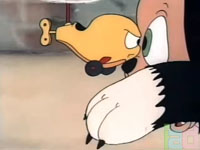 The frustrated mouse gives the little machine a swift kick in the key, toppling it off the shelf, down the ladder of a toy fire engine, and into a corner under a sales counter, where the helicopter weeps in disgrace at being unwanted. Meanwhile, two of the other mice collide their planes in flight, one clipping a wing off the other. The damaged plane crashes, and slides into the elevator shaft, falling to the lowest basement, where the cat is resting up from his failed capture attempt. The mouse lands at his very feet, and backs away fearfully into the empty shaft. The pleasantly-surprised cat confidently follows him in, pulling closed the elevator’s safety gate behind him (a seemingly needless precaution, as the gaps between the slats of the latticed gate are obviously wide enough for any mouse to slip through). Above, the other mice and the helicopter look down, as the cat pursues the fallen mouse around and around the shaft. The helicopter “rises” to the occasion, making a short hop over the other mice, then descending down the elevator shaft. Just as the cat corners the mouse and taste-tests him with a few licks, the helicopter lowers itself, so that it is staring into the cat’s face eye to eye. Having never seen such a contraption, the cat begins to hesitantly back away, while the helicopter advances to maintain the eye to eye stare with every step. Meanwhile, its wind-up key transforms in shape into a beckoning hand, giving a signal to the mouse to climb aboard. Once the mouse is in the cockpit, the helicopter abruptly spits in the cat’s eye, and rises out of reach. As the machine and mouse rise to join the others, the cat again repeats his temper tantrums, his meal lost again. The mice parade and cheer below the triumphant helicopter (in animation no doubt recycled many times later for the last shots of Mighty Mouse cartoons), for the fade out.
The frustrated mouse gives the little machine a swift kick in the key, toppling it off the shelf, down the ladder of a toy fire engine, and into a corner under a sales counter, where the helicopter weeps in disgrace at being unwanted. Meanwhile, two of the other mice collide their planes in flight, one clipping a wing off the other. The damaged plane crashes, and slides into the elevator shaft, falling to the lowest basement, where the cat is resting up from his failed capture attempt. The mouse lands at his very feet, and backs away fearfully into the empty shaft. The pleasantly-surprised cat confidently follows him in, pulling closed the elevator’s safety gate behind him (a seemingly needless precaution, as the gaps between the slats of the latticed gate are obviously wide enough for any mouse to slip through). Above, the other mice and the helicopter look down, as the cat pursues the fallen mouse around and around the shaft. The helicopter “rises” to the occasion, making a short hop over the other mice, then descending down the elevator shaft. Just as the cat corners the mouse and taste-tests him with a few licks, the helicopter lowers itself, so that it is staring into the cat’s face eye to eye. Having never seen such a contraption, the cat begins to hesitantly back away, while the helicopter advances to maintain the eye to eye stare with every step. Meanwhile, its wind-up key transforms in shape into a beckoning hand, giving a signal to the mouse to climb aboard. Once the mouse is in the cockpit, the helicopter abruptly spits in the cat’s eye, and rises out of reach. As the machine and mouse rise to join the others, the cat again repeats his temper tantrums, his meal lost again. The mice parade and cheer below the triumphant helicopter (in animation no doubt recycled many times later for the last shots of Mighty Mouse cartoons), for the fade out.

“Enemies of Democracy – Beware!”
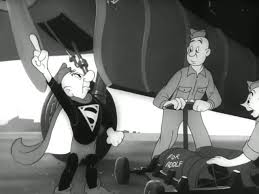 In a later sequence, Snafu spots a wave of German bombers closing in on a port town. He repeats Daffy Duck’s line from last week: “Messerschmitts! A whole mess of Messerschmitts!” As the bomb bay doors open, Snafu nimbly dives every which way, catching each bomb before it contacts the ground, and placing them all harmlessly in a pile on a nearby dock. He almost misses the last bomb, which falls down an industrial smokestack, but dives in and heroically rises with the weapon, without marring a brick of the factory. Placing the last bomb atop his stack, Snafu relaxes, believing the situation to be neutralized. A cutaway view of the bombs, however, reveals that each has a clock mechanism inside, wired as a time bomb. Shame on Snafu for forgetting to use his x-ray vision. BOOOOM! When the smoke clears, the scene has changed to a hospital bed. It was not a dream, and Snafu is well laid up. Technical Fairy asks if there is anything he can do for Snafu. The private responds that there is one thing – “GET ME A FIELD MANUAL!”
In a later sequence, Snafu spots a wave of German bombers closing in on a port town. He repeats Daffy Duck’s line from last week: “Messerschmitts! A whole mess of Messerschmitts!” As the bomb bay doors open, Snafu nimbly dives every which way, catching each bomb before it contacts the ground, and placing them all harmlessly in a pile on a nearby dock. He almost misses the last bomb, which falls down an industrial smokestack, but dives in and heroically rises with the weapon, without marring a brick of the factory. Placing the last bomb atop his stack, Snafu relaxes, believing the situation to be neutralized. A cutaway view of the bombs, however, reveals that each has a clock mechanism inside, wired as a time bomb. Shame on Snafu for forgetting to use his x-ray vision. BOOOOM! When the smoke clears, the scene has changed to a hospital bed. It was not a dream, and Snafu is well laid up. Technical Fairy asks if there is anything he can do for Snafu. The private responds that there is one thing – “GET ME A FIELD MANUAL!”
 We’ve also visited Bugs Bunny Nips the Nips before. (Warner, 4/22.44 – I. (Friz) Freleng, dir.). Bugs, packed in a floating crate fallen or blown off an unknown ship, kills time until the “island that always turns up in this kind of picture inevitably turns up”. Landing on just such an atoll, he finds it entirely occupied by the Japanese. He masquerades as a Japanese officer to fool one of the soldiers, but the soldier quickly sees through the disguise, remembering Bugs from seeing a Leon Schlesinger cartoon, and responds to him by chewing a carrot and asking, “What are up, honorable doc?” “Honorable yipe!”, reacts Bugs. Bugs runs for an airfield, and commandeers a Zero fighter, taking off into the sky. The soldier jumps into a second Zero, and takes off – but not before a rope is tied to his tail by Bugs, who has already landed his own plane behind the soldier. The other end of the rope is tied to a palm tree, and the plane is yanked out from under the soldier, just as Cottontail Smith’s plane was in “Super Rabbit”. The same gag is used of the soldier proceeding through the skies with only seat, control stick, and cockpit canopy. Also borrowing from “Goofy’s Glider”, the pilot goes through the unneeded formality of opening the canopy glass and climbing up onto its railing before bailing out, though there is already nothing underneath him. The chute opens, and the soldier sails slowly down to earth. But Bugs reappears with his plane, opening his cockpit canopy to place into the soldier’s hands a large anvil. “Here’s some scrap iron for Japan, Moto”, says Bugs, as the overloaded soldier drags the chute down in free fall for a terrific crash.
We’ve also visited Bugs Bunny Nips the Nips before. (Warner, 4/22.44 – I. (Friz) Freleng, dir.). Bugs, packed in a floating crate fallen or blown off an unknown ship, kills time until the “island that always turns up in this kind of picture inevitably turns up”. Landing on just such an atoll, he finds it entirely occupied by the Japanese. He masquerades as a Japanese officer to fool one of the soldiers, but the soldier quickly sees through the disguise, remembering Bugs from seeing a Leon Schlesinger cartoon, and responds to him by chewing a carrot and asking, “What are up, honorable doc?” “Honorable yipe!”, reacts Bugs. Bugs runs for an airfield, and commandeers a Zero fighter, taking off into the sky. The soldier jumps into a second Zero, and takes off – but not before a rope is tied to his tail by Bugs, who has already landed his own plane behind the soldier. The other end of the rope is tied to a palm tree, and the plane is yanked out from under the soldier, just as Cottontail Smith’s plane was in “Super Rabbit”. The same gag is used of the soldier proceeding through the skies with only seat, control stick, and cockpit canopy. Also borrowing from “Goofy’s Glider”, the pilot goes through the unneeded formality of opening the canopy glass and climbing up onto its railing before bailing out, though there is already nothing underneath him. The chute opens, and the soldier sails slowly down to earth. But Bugs reappears with his plane, opening his cockpit canopy to place into the soldier’s hands a large anvil. “Here’s some scrap iron for Japan, Moto”, says Bugs, as the overloaded soldier drags the chute down in free fall for a terrific crash.
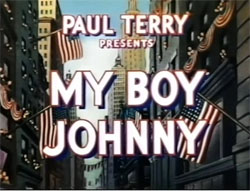 My Boy Johnny (Terrytoons/Fox, 5/12/44 – Eddie Donnelly, dir.) – It is uncertain what made the Terry studios think about doing a cartoon on the was coming to an end so early and agead of schedule of the actual event. There does not appear to be a direct correlation between the timing of any action in the war and this cartoon which would lead one to believe that the studio staff really felt the end of hostilities was right around the corner. Perhaps it was just someone’s pleasant daydream, and someone thought sharing it might boost general morale. If so, it was a good gamble, for someone must have liked the concept, as the film garnered one of the studio’s few shots at the Academy Award, receiving a nomination for that season.
My Boy Johnny (Terrytoons/Fox, 5/12/44 – Eddie Donnelly, dir.) – It is uncertain what made the Terry studios think about doing a cartoon on the was coming to an end so early and agead of schedule of the actual event. There does not appear to be a direct correlation between the timing of any action in the war and this cartoon which would lead one to believe that the studio staff really felt the end of hostilities was right around the corner. Perhaps it was just someone’s pleasant daydream, and someone thought sharing it might boost general morale. If so, it was a good gamble, for someone must have liked the concept, as the film garnered one of the studio’s few shots at the Academy Award, receiving a nomination for that season.
The production has no real plot, but is a gentle-natured spot-gag reel, similar in style to a Tex Avery “World of Tomorrow” cartoon, but with a hopeful rather than a satiric edge. It attempts to answer the basic question, What will the world be like when our boys return to their native land? The scene opens upon the window of a typical American home where a pennant with red border, white field, and blue star is displayed – indicator of the day that some member of the family was serving in the armed forces. The camera zooms into the center of the star, and the scene changes ro rows of troop transport ships and planes making the long trek back from Europe to New York City. On Manhattan Island, the last blackout ends, and the Great White Way returns to being ablaze with light. As transport planes pass over New York Harbor, the Statue of Liberty springs to life and performs cartwheels in celebration. Rather than wait for a landing, many of the troops disembark to their home towns by way of parachute. As usual, a generic Terry mouse is among them, repeating Jerry Mouse’s gag from “The Yankee Doodle Mouse” of the preceding year, by using a two-cup bra to “hit the silk”. Two other disembarking soldiers are Terry’s first two to sign up for the war – Gandy Goose, and Rudy Rooster. Gandy lands in his own backyard, to be greeted by his Missus, last seen in “The One Man Navy”, and a brand new flock of goslings. (We hope Gandy had been on previous leave for a visit, as a flock of newborns might seem suspicious after a three-year absence). Rudy Rooster might wonder the same thing. He lands in his barnyard, and lets out a mighty crow to signal he’s home. He’s apparently forgotten, however, how overwhelming it can be if all the hens of his harem try to renew old acquaintances at once, and when they all begin pursuing him, Rudy turns tail and runs for it, hiding out inside one of the chicken coops while the girls pound on the door for entrance. Inside isn’t much more peaceful, as dozens of half-hatched eggs clamber onto his back and shoulders and begin dancing around in celebration, while Rudy just gives a perplexed look to the camera as if to say. “What are ya gonna do?”
 The work force is re-employed, and factories hum with old and new inventions. One plant mass produces washing machines that automatically put the clothes through the wash cycle, then wring them out to dry, and hang them on a pop-out rotating clothesline. Another plant turns out a by-product of war – jeeps for civilians, which sell well as substitutes for bucking broncos at the local rodeo. Modern homes are built, with Frank Lloyd Wright touches in their design and curvature, coming very close to the modern house displayed in Chuck Jones’ later “House Hunting Mice”. Gandy and family are one of the first to explore one of these new homes open for demonstration. Upon entering, mechanical hands rise from panels in the floor to take his hat, and dust him off with a whish broom while Gandy stands upon a spinning turntable. One of Gandy’s goslings pushes a panel of additional buttons to give Daddy the “works”. The floor slides Gandy to a medicine cabinet, where more mechanical hands automatically brush his teeth. He is zipped off to a bathroom, with a creative mechanism placing Gandy upon a large rectangular platform with drain holes. The panel suddenly sinks 3 feet depositing Gandy in a tub of water automatically filled as the floor panel descends. A painted swan on a wall mural turns out to have a built-in shower, streaming a flow of water from its beak. The floor panel rises as suddenly as it sank, with the water draining out through its holes, while two more mechanical hands rise from the floor and towel Gandy off vigorously from both sides. He is spiraled back to the spot where he entered the home, reoutfitted in his hat by the hands, and a lit cigar is placed into his bill, before the floor slides him outside and dumps him on the doorstep. Gandy’s a bit shaken, but comfortable with his smoke, smiling a satisfied smile to the camera.
The work force is re-employed, and factories hum with old and new inventions. One plant mass produces washing machines that automatically put the clothes through the wash cycle, then wring them out to dry, and hang them on a pop-out rotating clothesline. Another plant turns out a by-product of war – jeeps for civilians, which sell well as substitutes for bucking broncos at the local rodeo. Modern homes are built, with Frank Lloyd Wright touches in their design and curvature, coming very close to the modern house displayed in Chuck Jones’ later “House Hunting Mice”. Gandy and family are one of the first to explore one of these new homes open for demonstration. Upon entering, mechanical hands rise from panels in the floor to take his hat, and dust him off with a whish broom while Gandy stands upon a spinning turntable. One of Gandy’s goslings pushes a panel of additional buttons to give Daddy the “works”. The floor slides Gandy to a medicine cabinet, where more mechanical hands automatically brush his teeth. He is zipped off to a bathroom, with a creative mechanism placing Gandy upon a large rectangular platform with drain holes. The panel suddenly sinks 3 feet depositing Gandy in a tub of water automatically filled as the floor panel descends. A painted swan on a wall mural turns out to have a built-in shower, streaming a flow of water from its beak. The floor panel rises as suddenly as it sank, with the water draining out through its holes, while two more mechanical hands rise from the floor and towel Gandy off vigorously from both sides. He is spiraled back to the spot where he entered the home, reoutfitted in his hat by the hands, and a lit cigar is placed into his bill, before the floor slides him outside and dumps him on the doorstep. Gandy’s a bit shaken, but comfortable with his smoke, smiling a satisfied smile to the camera.
Transportation is revolutionized. Instead of cars, every house comes equipped with its own personal helicopter. Commercial transportation has grown to modern superplanes, with double-decker passenger cabins (predicting the lounges added to many models of Jumbo Jets), and the fantastic additions of a swimming pool, sun-deck, and bicycle track atop the plane’s roof, and two restaurant/night clubs complete with dining tables and dancing to live bands available on each wing. Even former pedestrians take to the skies, with helicopter propellers attached to belts around their waist (a smaller model is even available to walk Rover), and flying ice cream wagons provide service to children in flying kiddie cars.
Construction has almost developed to the point of an “instant” endeavor. A futuristic cement mixer is shaped like a cocktail shaker, and mixes vigorously in such fashion, before sprouting a helicopter propeller and taking off into the sky, pouring concrete out a spout as it goes. It pours entire highways as fast as it can fly over the land, including concrete columns to ford a river canyon with a a tall-tiered bridge, and graceful arches to provide overpasses where roads cross – all of these creations filling with cars as quickly as they are poured. The gizmo even beats the speed record of Friz Freleng’s crew from “Rhapsody in Rivets” in building skyscrapers, by simply pouring out a skyscraper from the ground up, rising fifty or so stories high, then topping the structure with a crowning touch of a spiral swirl of concrete resembling the top of a soft-serve ice cream cone, and adding a giant cherry! (This animation would be reused years later for a similar futuristic theme, in Mighty Mouse’s “The Electronic Mouse Trap”.)
The film finally ends with the bachelors of the troops marching into town, each with a photo of a pin-up girl hooked upon the tip of their bayonets. A chorus sings “The pin-up girl will come to life, and be some soldier’s loving wife.” Thus, a parade of soldiers and their brides to be march solemnly into wedding chapels all around the country, and stand taking their vows, as the film fades out.
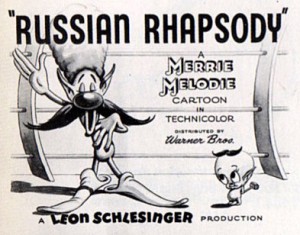 Russian Rhapsody (Warner. Merrie Melodies, 5/20/44 – Robert Clampett, dir.) – Held back for a time in the wake of Disney’s efforts to get a Gremlins feature off the ground, this cartoon was originally to be titled “Gremlins From the Kremlin” to match its featured song, a lyrical parody on “Dark Eyes”. The story commences way back in 1941, with German news headlines announcing squad after squad of Nazi bombers failing to reach Moscow. One paper questions, “Could it be Gremlins?” Another responds “Um-m-m-m, Could Be.” Hitler, giving a speech for “the New Odor”, rages in German-laced gibberish, punctuated by the phrases, “Friz Freleng”, “zoot suit with a reet pleat”, and “Chattanooga Choo-Choo”, and sentences ending with the words “Gesundheit” and “What’s Cookin’ Doc?”, while a human hand holds a card over the screen reading, “Silly, isn’t he?” The Fuehrer promises to send his top “superman” to personally bomb Moscow. Someone from the crowd asks, “Who is that?. You, Fuehrer?” “Who else?”, responds Adolf in mock modesty.
Russian Rhapsody (Warner. Merrie Melodies, 5/20/44 – Robert Clampett, dir.) – Held back for a time in the wake of Disney’s efforts to get a Gremlins feature off the ground, this cartoon was originally to be titled “Gremlins From the Kremlin” to match its featured song, a lyrical parody on “Dark Eyes”. The story commences way back in 1941, with German news headlines announcing squad after squad of Nazi bombers failing to reach Moscow. One paper questions, “Could it be Gremlins?” Another responds “Um-m-m-m, Could Be.” Hitler, giving a speech for “the New Odor”, rages in German-laced gibberish, punctuated by the phrases, “Friz Freleng”, “zoot suit with a reet pleat”, and “Chattanooga Choo-Choo”, and sentences ending with the words “Gesundheit” and “What’s Cookin’ Doc?”, while a human hand holds a card over the screen reading, “Silly, isn’t he?” The Fuehrer promises to send his top “superman” to personally bomb Moscow. Someone from the crowd asks, “Who is that?. You, Fuehrer?” “Who else?”, responds Adolf in mock modesty.
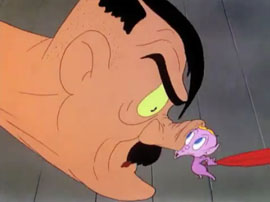
“Russian Rhapsody”
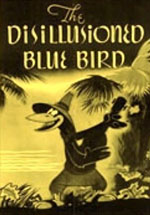 I will defer detailed description of The Disillusioned Blue Bird (Columbia/Screen Gems, Color Rhapsody, 5/26/44 – Howard Swift, dir.) for a planned subsequent article. For our present purposes, it opens with a brief heavenly chorus singing of the happiness and tranquility that bluebirds bring to the world, and of listening for the bluebird calling – followed by the resounding call of “HELP!”. Our title bird has his hands full, as he attempts to dodge out from under falling bombs, flak from descending rows of fighter panes, and shelling from anti-aircraft guns, much like the stork in MGM’s The Stork’s Holiday. He winds up unexpectedly taking a ride upon a long-range projectile, which lands him on a small island in the Caribbean seas. There, he meets up with a community of calypso-singing crows and cranes, who musically teach him their easy-going ways, and that he should never be disillusioned, as long as he is free. A Columbia bow to the good-neighbor policy, similar in style to “The Three Caballeros”.
I will defer detailed description of The Disillusioned Blue Bird (Columbia/Screen Gems, Color Rhapsody, 5/26/44 – Howard Swift, dir.) for a planned subsequent article. For our present purposes, it opens with a brief heavenly chorus singing of the happiness and tranquility that bluebirds bring to the world, and of listening for the bluebird calling – followed by the resounding call of “HELP!”. Our title bird has his hands full, as he attempts to dodge out from under falling bombs, flak from descending rows of fighter panes, and shelling from anti-aircraft guns, much like the stork in MGM’s The Stork’s Holiday. He winds up unexpectedly taking a ride upon a long-range projectile, which lands him on a small island in the Caribbean seas. There, he meets up with a community of calypso-singing crows and cranes, who musically teach him their easy-going ways, and that he should never be disillusioned, as long as he is free. A Columbia bow to the good-neighbor policy, similar in style to “The Three Caballeros”.
 Going Home (Warner, Private Snafu – Charles M. (Chuck) Jones, dir.), was produced in 1944 but never released Speculations as to the decision to shelve the completed film range from depiction of a weapon that may have been felt too close in resemblance to the atomic bomb, or too negative an ending to the story. Similar in style and lesson to the earlier Spies, but not depicting a listening enemy, Snafu blabs to everyone on his return home everything he knows of military operations, forgetting that others remain on the battlefront. In a theater, Snafu sees a newsreel about a Japanese island getting hit by a secret weapon that leaves nothing but a huge crater, then blabs to his girlfriend that the weapon is a flying bazooka, giving every specification, so that an illustrated chart of the weapon appears on the screen above him for all the audience to see. More “dope” spilled to his barber is illustrated by a narrator as being the equivalent of skywriting the information all over town, as a visualization shows Snafu in a plane writing in smoke details about installations, number of troops, secret weapons, etc. Finally, while jitterbugging with his girlfriend to a hot tune on the radio, Snafu hears a news bulletin that the entire 999th division has been annihilated. “My own outfit”, reacts a shocked Snafu. “Some guy shot his mouth off. Any jerk who’d do that ought to be run over by a streetcar.” Repeating Freleng’s gag from The Trial of Mr. Wolf (1941), a streetcar smashes through the house wall on cue, to perform just such a task.
Going Home (Warner, Private Snafu – Charles M. (Chuck) Jones, dir.), was produced in 1944 but never released Speculations as to the decision to shelve the completed film range from depiction of a weapon that may have been felt too close in resemblance to the atomic bomb, or too negative an ending to the story. Similar in style and lesson to the earlier Spies, but not depicting a listening enemy, Snafu blabs to everyone on his return home everything he knows of military operations, forgetting that others remain on the battlefront. In a theater, Snafu sees a newsreel about a Japanese island getting hit by a secret weapon that leaves nothing but a huge crater, then blabs to his girlfriend that the weapon is a flying bazooka, giving every specification, so that an illustrated chart of the weapon appears on the screen above him for all the audience to see. More “dope” spilled to his barber is illustrated by a narrator as being the equivalent of skywriting the information all over town, as a visualization shows Snafu in a plane writing in smoke details about installations, number of troops, secret weapons, etc. Finally, while jitterbugging with his girlfriend to a hot tune on the radio, Snafu hears a news bulletin that the entire 999th division has been annihilated. “My own outfit”, reacts a shocked Snafu. “Some guy shot his mouth off. Any jerk who’d do that ought to be run over by a streetcar.” Repeating Freleng’s gag from The Trial of Mr. Wolf (1941), a streetcar smashes through the house wall on cue, to perform just such a task.
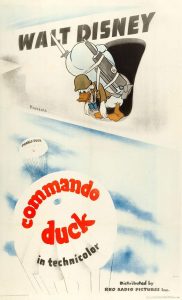 Commando Duck (Disney, RKO, Donald Duck, 6/2/44 – Jack King, dir.) – Flown deep into jungle territory occupied by the Japanese, Donald Duck stands at trembling attention, with full gear, about to be parachuted out of a plane on a top-secret mission. A Japanese air base is located down-river in the vicinity. Donald’s mission is to travel through crocodile-infested waters, evade the enemy, and wipe out the base single-handed. Piece of cake, right? Donald’s not so sure, as he perspires profusely. He receives the order to bail out. The ripcord hook from his backpack works like a charm, but Donald glances in an instruction book to make sure he has his knees bent in the proper position for a landing. With his nose still in the book, he feels his descent come to a stop, and smiles to the audience, “Nothing to it.” Had he only looked up or down, he would have seen that he is not on the ground at all, but his chute is merely snagged on the limbs of two trees extending from opposite walls of a narrow canyon. Donald reads the book’s next instruction, “unbuckle belt”, and immediately plunges into the canyon below, leaving nearly all of his gear behind with the parachute. Below him in the river wait two hungry crocodiles with jaws open. Borrowing a gag from Popeye, Donald times his descent to reach out and seal the crocodiles’ teeth together with a pull of a zipper across their lips. Donald reaches the relative safety of the riverbank, and still finds himself in possession of one needed piece of equipment – a fantastic pocket-size inflatable boat, which he begins to blow up into a full sized rubber raft.
Commando Duck (Disney, RKO, Donald Duck, 6/2/44 – Jack King, dir.) – Flown deep into jungle territory occupied by the Japanese, Donald Duck stands at trembling attention, with full gear, about to be parachuted out of a plane on a top-secret mission. A Japanese air base is located down-river in the vicinity. Donald’s mission is to travel through crocodile-infested waters, evade the enemy, and wipe out the base single-handed. Piece of cake, right? Donald’s not so sure, as he perspires profusely. He receives the order to bail out. The ripcord hook from his backpack works like a charm, but Donald glances in an instruction book to make sure he has his knees bent in the proper position for a landing. With his nose still in the book, he feels his descent come to a stop, and smiles to the audience, “Nothing to it.” Had he only looked up or down, he would have seen that he is not on the ground at all, but his chute is merely snagged on the limbs of two trees extending from opposite walls of a narrow canyon. Donald reads the book’s next instruction, “unbuckle belt”, and immediately plunges into the canyon below, leaving nearly all of his gear behind with the parachute. Below him in the river wait two hungry crocodiles with jaws open. Borrowing a gag from Popeye, Donald times his descent to reach out and seal the crocodiles’ teeth together with a pull of a zipper across their lips. Donald reaches the relative safety of the riverbank, and still finds himself in possession of one needed piece of equipment – a fantastic pocket-size inflatable boat, which he begins to blow up into a full sized rubber raft.
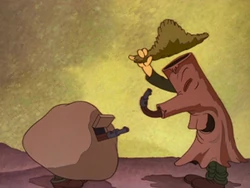 Lurking in the foliage behind him, a suspicious-looking tree, with countenance on its bark roughly resembling a Japanese face, and an equally suspicious boulder, reveal the muzzles of concealed weapons within. The boulder leans against the tree’s muzzle, curving it upwards. An attempted shot by the tree curves around and hits the tree in its “rear end”, as a Japanese-accented voice reacts with a howl. The boulder, in the same accent, apologizes profusely to the tree, each of the two engaging in a seemingly endless series of bows to the other amidst mock-Japanese chatter. As Donald’s raft hits the water, more hands of Japanese soldiers appear from the brush, each carrying a rifle. One voice expresses anxiousness to fire, but another reminds him of old Japanese custom to always shoot a man in the back. At the appropriate moment, the shooting spree begins. Seeing objects whizzing past him in the air, Donald assumes them to be mosquitos. He swats at them with his helmet, only to have the helmet become chock fill of spent bullet casings. The duck looks back, and has both his tail feathers and his scalp parted down the middle by another shot. “Snipers!”, shouts the duck, paddling for his life with the butt of his gun, while his feet stretch the rubber bottom of the raft, permitting him to literally walk on water. He reaches a point where he believes himself to be out of firing range, but finds his raft headed straight for a precarious drop from a waterfall. Paddling the opposite direction gets him nowhere, and as his craft tips over the falls’ edge, Donald throws a rope, lassoing a rock on the riverbank. Donald strains to pull his raft upwards, but one last sniper draws a bead with his crosshair sights upon the rope, stating to himself, “Must shoot rope in the center of the middle, just like the Lone Ranger”. His shot scores a hit, and the sniper reacts with Red Skelton’s catch-phrase, “I dood it!” The raft falls uncontrollably, but catches in the crotch of a tree extending out through the water from the mountainside. The rubber raft becomes lodged in the tree branches so as to act as a cup, taking on the water of the falls within its insides.
Lurking in the foliage behind him, a suspicious-looking tree, with countenance on its bark roughly resembling a Japanese face, and an equally suspicious boulder, reveal the muzzles of concealed weapons within. The boulder leans against the tree’s muzzle, curving it upwards. An attempted shot by the tree curves around and hits the tree in its “rear end”, as a Japanese-accented voice reacts with a howl. The boulder, in the same accent, apologizes profusely to the tree, each of the two engaging in a seemingly endless series of bows to the other amidst mock-Japanese chatter. As Donald’s raft hits the water, more hands of Japanese soldiers appear from the brush, each carrying a rifle. One voice expresses anxiousness to fire, but another reminds him of old Japanese custom to always shoot a man in the back. At the appropriate moment, the shooting spree begins. Seeing objects whizzing past him in the air, Donald assumes them to be mosquitos. He swats at them with his helmet, only to have the helmet become chock fill of spent bullet casings. The duck looks back, and has both his tail feathers and his scalp parted down the middle by another shot. “Snipers!”, shouts the duck, paddling for his life with the butt of his gun, while his feet stretch the rubber bottom of the raft, permitting him to literally walk on water. He reaches a point where he believes himself to be out of firing range, but finds his raft headed straight for a precarious drop from a waterfall. Paddling the opposite direction gets him nowhere, and as his craft tips over the falls’ edge, Donald throws a rope, lassoing a rock on the riverbank. Donald strains to pull his raft upwards, but one last sniper draws a bead with his crosshair sights upon the rope, stating to himself, “Must shoot rope in the center of the middle, just like the Lone Ranger”. His shot scores a hit, and the sniper reacts with Red Skelton’s catch-phrase, “I dood it!” The raft falls uncontrollably, but catches in the crotch of a tree extending out through the water from the mountainside. The rubber raft becomes lodged in the tree branches so as to act as a cup, taking on the water of the falls within its insides.
 Donald finds himself at the bottom of the falls (now reduced to a semi-dry riverbed by the interference with the water flow), within the confines of a giant and ever-growing rubber water-balloon. His helmet remains on the ground outside the balloon, and Donald stretches the rubber to try to place the hat on his head from outside – not very successfully. Realizing he has to get out, Donald somehow manages to swim against the current of the internal waters, to climb out the upper lips of the raft enclosure. But as he slides down the outside of the balloon to reach ground, the raft keeps growing larger, and larger, and larger, until it’s ballooning shape is a wide as the canyon itself, and has nowhere left to expand except downstream. Its shadow looms over Donald, who barely rescues his rifle/bayonet from being buried underneath the balloon’s crushing weight, as well as having to dig himself out from under it with the bayonet point. Donald races further down the canyon at top speed, with the balloon matching him stride for stride. Ahead, Donald spots a stray piece of board in the riverbed, with a protruding nail point. With not a second to spare, Donald flips the board over while passing, so that the tack is pointed into the mud as the balloon passes overhead. A large plant with pointed limbs is also rendered harmless, by Donald placing corks from nowhere on the end of each limb. Finally, a huge log is encountered, resting sideways on a rocky fulcrum, with a sharp wooden point facing the oncoming bubble. Donald wastes no time in spinning the log around to point in the opposite direction – never noting that the opposite end of the log has an even sharper point! Before Donald knows it the sound of rubber being stretched to its maximum stress point is heard, and a mammoth explosion follows. The force of the blast not only releases the rushing waters, but an avalanche of massive boulders, which pursue Donald in an endless line of near-misses. The canyon floor also cracks open as if an earthquake hit it, and Donald straddles both sides of the crack, while the boulders roll down the trench in the canyon floor as if steel balls following the entry track of a pinball machine.
Donald finds himself at the bottom of the falls (now reduced to a semi-dry riverbed by the interference with the water flow), within the confines of a giant and ever-growing rubber water-balloon. His helmet remains on the ground outside the balloon, and Donald stretches the rubber to try to place the hat on his head from outside – not very successfully. Realizing he has to get out, Donald somehow manages to swim against the current of the internal waters, to climb out the upper lips of the raft enclosure. But as he slides down the outside of the balloon to reach ground, the raft keeps growing larger, and larger, and larger, until it’s ballooning shape is a wide as the canyon itself, and has nowhere left to expand except downstream. Its shadow looms over Donald, who barely rescues his rifle/bayonet from being buried underneath the balloon’s crushing weight, as well as having to dig himself out from under it with the bayonet point. Donald races further down the canyon at top speed, with the balloon matching him stride for stride. Ahead, Donald spots a stray piece of board in the riverbed, with a protruding nail point. With not a second to spare, Donald flips the board over while passing, so that the tack is pointed into the mud as the balloon passes overhead. A large plant with pointed limbs is also rendered harmless, by Donald placing corks from nowhere on the end of each limb. Finally, a huge log is encountered, resting sideways on a rocky fulcrum, with a sharp wooden point facing the oncoming bubble. Donald wastes no time in spinning the log around to point in the opposite direction – never noting that the opposite end of the log has an even sharper point! Before Donald knows it the sound of rubber being stretched to its maximum stress point is heard, and a mammoth explosion follows. The force of the blast not only releases the rushing waters, but an avalanche of massive boulders, which pursue Donald in an endless line of near-misses. The canyon floor also cracks open as if an earthquake hit it, and Donald straddles both sides of the crack, while the boulders roll down the trench in the canyon floor as if steel balls following the entry track of a pinball machine.
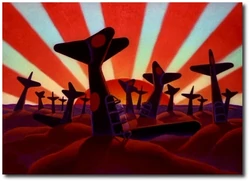 Finally, Donald reaches the end of the line, running to the forward edge or a log overhanging the drop off of a vertical cliff, where, far below in a valley, the hangars and planes of the Japanese military installation can be seen. With the water and boulders only a few seconds away, Donald prepares to take his medicine, and stands in salute like a good soldier, ready to lay down his life for his country. Instead, one of the boulders lands on the opposite end of his log, and catapults Donald to the safety of another high tree branch overlooking the valley. The base below isn’t so lucky, and is completely submerged in the flow of water and rock. As the waters pass and recede, Donald surveys the damage with his binoculars. Battered planes lie everywhere, some hanging from telephone wires as if clothes on a clothesline to dry, another resembling a roast chicken turning on a spit, and the tails of others forming the pattern of the rising sun flag against a setting sun. Donald pulls out a pencil and notepad to write a communique back to his superiors. “Contacted enemy. Wiped…” Donald crosses out the last word, replacing it with “Washed out same.”
Finally, Donald reaches the end of the line, running to the forward edge or a log overhanging the drop off of a vertical cliff, where, far below in a valley, the hangars and planes of the Japanese military installation can be seen. With the water and boulders only a few seconds away, Donald prepares to take his medicine, and stands in salute like a good soldier, ready to lay down his life for his country. Instead, one of the boulders lands on the opposite end of his log, and catapults Donald to the safety of another high tree branch overlooking the valley. The base below isn’t so lucky, and is completely submerged in the flow of water and rock. As the waters pass and recede, Donald surveys the damage with his binoculars. Battered planes lie everywhere, some hanging from telephone wires as if clothes on a clothesline to dry, another resembling a roast chicken turning on a spit, and the tails of others forming the pattern of the rising sun flag against a setting sun. Donald pulls out a pencil and notepad to write a communique back to his superiors. “Contacted enemy. Wiped…” Donald crosses out the last word, replacing it with “Washed out same.”
Victory seems ever closer, next time.


 Charles Gardner is an animation enthusiast who toils by day as a member of LA Law – but by nights and weekends indulges in classic jazz and ragtime as a performer; and studies classic Hollywood cartoons… maybe a little too much.
Charles Gardner is an animation enthusiast who toils by day as a member of LA Law – but by nights and weekends indulges in classic jazz and ragtime as a performer; and studies classic Hollywood cartoons… maybe a little too much.


































































































































































Russian Rhapsody is my favorite wartime cartoon.
Hitler’s speech never fails to crack me up.
“My Boy Johnny” would have been a morale-booster for a population weary of shortages and rationing; notice how the refrigerators coming off the assembly line are conspicuously shown to be full of meat. But the glories of a prosperous postwar world were a common feature in advertising at this time. Corporations that had converted to military production, and consequently had no consumer goods to sell, still wanted to keep their names in the public eye; many of them did this with the promise of better things to come. So, for example, Nash ran magazine ads showing cheerful veterans driving brand new cars that would not come off the assembly line for another few years; while Bell & Howell advertised its film projectors in National Geographic, stressing the point that they were not currently available to civilians. But just wait until the war is over!
The headlines shown in “Russian Rhapsody” (over the ominous strains of Wagner’s “Rienzi” Overture) were clearly taken from a German-language newspaper printed in America. No newspaper in Nazi Germany would have run a headline like “Marshal Rommel is no superman, says Eisenhower”! Other headlines tell of the Allies’ impending victory in the Tunisian campaign, which would date the edition to April or May 1943, a full year before the cartoon was released.
That’s by far the best-looking print of “Bugs Bunny Nips the Nips” I’ve ever seen.
Looking forward to what’s coming up in next week’s post. As Mr. McGuire told Ben in “The Graduate”, “There’s a great future in plastics!”
Thank you for this whole series of articles! I’m bookmarking them and will revisit many times – especially the 1940s era stuff!
Animation Goes to War! Your series as top notch. Thanks very much for all your work.